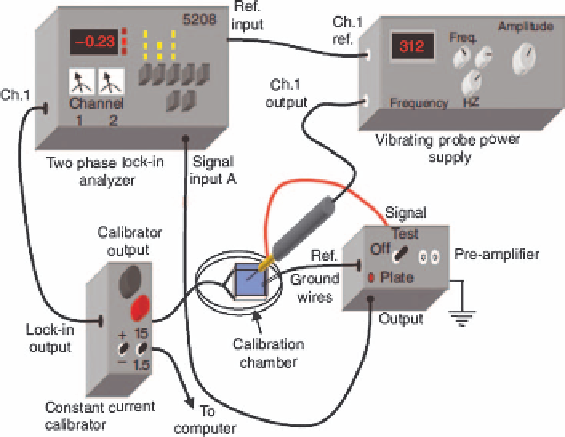Biomedical Engineering Reference
In-Depth Information
d
n
4
t
3
n
g
|
2
Figure 5.2
Calibration procedure for vibrating probe.
1
(Reprinted by kind permission of the Rockefeller University Press.)
n
3
.
In the presence of a physiological ionic current, the probe detects a voltage
difference between the extremes of its position. The calibration procedure is
rather complicated (Figure 5.2), but the system is low-cost and useful in
detecting bioelectric currents generated by living cells. For example,
Nuccitelli has shown that a steady current with an average surface density of
0.1-0.2 mAcm
2
enters the tail of an amoeba and leaves at its pseudopodes.
This current is reduced when the Ca
21
in the media is reduced. It is either a
current carried by Ca
21
ions or the absence of calcium affects the fluxes of other
ions such as Cl
. Jaffe later demonstrated the detection of subtle calcium
gradients using calcium selective vibrating electrodes in different embryonic
systems during cellular development. The method can be extended to measure
any ionic gradients of interest (H
1
,Mg
21
,K
1
,Na
1
).
2
In a surprising twist of
fate, Nuccitelli's work is now resurrected and was recently published in leading
scientific journals.
3
One interesting practical application of this technique is the non-invasive
measurement of electric current in human corneal wounds using a vibrating
probe to test the feasibility of pharmacologically enhancing the current to
promote corneal wound healing. Unwounded cornea were found to have small
outward currents (0.07 mAcm
2
).
4
Wounding increased the current more than
five-fold (0.41 mAcm
2
). Monitoring the wound current over time showed that
it seemed to be actively regulated and maintained above normal unwounded
levels for at least six hours. Drug treatment with aminophylline or chloride-free
solution more than doubled the size of wound currents, which correlated
directly with the wound healing rate.

